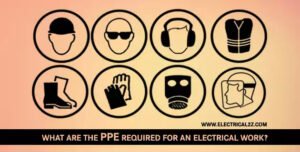Electrical Equipment Safety | The article is all about rules and regulations of the electrical safety for the equipment. The rules and regulations are the compulsory to follow every electricians.
Table of Contents
Electrical Equipment Safety
Authorized person
An authorized person is one who is specifically empowered by the administration to carry out a specified task or duty. This authority is usually given in the form of a ‘Certificate of Competence’ which clearly defines the responsibility resting on each person, by virtue of his holding any particular category of post. The following are some example of competency certificates.
Unskilled laborer
Authorized to carry out external cleaning of electrical equipment, renew lamps and fuses, and assist electric fitters to carry out work on electrical equipment. He shall not work on any aerial line or internal parts of electrical equipment unless they have been made dead and earthed by the electric fitter or chargeman.
Skilled electric fitter or electrician
Authorized to affect shutdown, test, earth and issue line-clear certificates on low and medium tension lines and circuits, directly under his charge: supervise the work of khallasis and laborer; render artificial respiration. He shall not test or earth high tension lines or circuits except under the direct supervision of an electrical foreman or electrical chargeman. He shall not bring into commission any new electrical installation.
High tension linesman
Authorized to test and earth H.T lines, provided that he has received a ‘permit-to-work’ from competent authority after the supply to the lines have been cut off. He is also authority to give line-clear certificate after work is completed and staff is withdrawn from the work.
Substation operator
Authorized to effect shutdown on any feeder, on receipt of requisition and issue ‘permit-to-work’ and to energies the feeder after receiving the line –clear certificate, from the party concerned.
Electric Foreman, Electric Chargeman
Authorized to effect shutdown, test and earth H.T lines under his charge and issue ‘permit-to work’; supervise the work of subordinate staff; commission new low and medium tension equipment and installation after ensuring that they comply with the rules. He is not authorized to commission any new H.T installation or do any modification to an existing installation; un till it has been inspected and passed by competent authority.
It should be noted that a competency certificate is a personal document of the person concerned and his work cannot, therefore, be delegated to someone else. A register of authorized persons should be maintained in every office.
Procedure for Shutdown
Before starting the shutdown process, it is important to get the ‘Permission for shutdown and ‘Permit to work’.
The following are the essential steps to be taken:
Step 1: study the circuit and identify the circuit breakers or control switches to be opened.
Step 2: open and lock the circuit breaker or switch in the ‘off’ position and keep the key in your Personal custody. If the switch cannot be locked out, remove the fuses and keep them under lock and key. Disconnect neutral link if any.
Step3: Hang or tie a ‘men-at-work’ notice board on the circuit breaker or switch handle.
Step4: Test for supply after making sure that the testing device itself is ok.
Step5: Earth the equipment.
Testing Device for Electricity – Electrical Equipment Safety
In low voltage circuit where the supply voltage is below 250 volts, one 250 volts lamp could be used as a test lamp. In the case of medium tension installations, two 250 volts lamps in series would be satisfactory. Alternatively, a voltmeter could be used. For higher voltages of the order of 2.2 to 11 kv, one type of tester is the ‘spark’ tester, where a sharply pointed metal cone fixed at the end of an insulated handle draws sparks when the pointed end is brought very close (about ¼ in.) to the live conductor.
The spark is faint and therefore, liable to be erroneously judged. There is also ‘neon testers’ specially designed for testing live circuits. These give a much better indication. Another way is to make use of a potential transformer with a voltmeter connected to the secondary circuit. Care should, however, be taken to usefully insulated handles when making the contact with the live wire. Another convenient device is the electrostatic voltmeter.
For higher voltages, above 11KV it will be necessary to rely entirely upon the correct switching operations being carried out at the substations, and a foolproof system of exchange of the necessary shutdown messages. However , a very interesting development in this field is the ‘metric live –line indicator’ which does not require any contact to be made with the live line but is designed to detect the electrostatic field set up in the vicinity of a conductor energized by an a.c. voltage. It is made in two models: 33 to 275 kV and 22 to 66 kV by Messrs Everett Edgcumbe.
It has been specially developed for verifying the isolation of the higher voltage apparatus before working on it. It gives a clear reading on an illuminated scale in the presence of an energized conductor. It weighs less than 2 lb. including self contained batteries and is a very convenient one-hand instrument.
Special Shutdown Precautions in Substations and Power House
The following points require attention:
1. In substation and power houses, where several supervisory staff are on duty at the same time, it is important that the responsibility for effecting shutdown and resuming supply should devolve only on one ‘authorized person’ at any time, who will be in overall control of the switching operations, and no operation should be carried out without his personal knowledge. This is particularly important in times of trouble or failure of supply when different officials present a like to give conflicting orders.
2. In addition to switching off the circuit breaker, the corresponding isolating switch should also be opened. Even where the isolating switch is provided with an earthing device in its ‘off’ position independent earthing of the lines should be done at the work spot.
3. The authorized official in charge must be thoroughly familiar with the circuit layout and interconnections.
For instance, it is not enough to switch off the H.T circuit breaker for isolating a transformer. The transformer terminals may continue to be alive through the L.T side. Similarly ring mains or bus-couplers may feed currents into equipment, even though the direct link has been cut off.
Final Word
Hope you understand this article about the Electrical Equipment Safety: Rules and Regulations. Incase of any doubt please comment below. Subscribe our website to get every new post update to your email. Please follow our website @ElectricianWorld.Net for future updates. Thank you for visiting our website.


